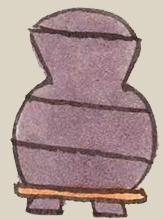cuezcomatl (Mdz16r)
This element for granary (cuezcomatl) has been carved from the compound sign for the place name, Cuezcomaixtlahuacan. It is colored purple, and it has a lid, horizontal lines, a horizontal base colored terracotta, and two visible purple feet. The granary might be made of a ceramic material with a wooden base.
Stephanie Wood
It is difficult to determine whether this granary bin for storing maize was wooden or ceramic. The lid with the handle looks somewhat like molded ceramic. Some cuezcomates are purple and some are orange in this collection. Perhaps with further research it will become clearer why the colors vary so much. Some have stones under them, and some do not, but most are elevated above the ground.
Sometimes a cuezcomatl was large enough to have its own solid foundation, as has been indicated in archaeological studies of household compounds. See, for example, Deborah L. Nichols and Christopher A. Pool, The Oxford Handbook of Mesoamerican Archaeology (2012), p. 920. One can also see surviving cuezcomatl in places such as Morelos today, where they typically have a thatched roof. A manuscript from Huexotzinco also shows a thatched cuezcomatl.
James Lockhart, as cited in our online dictionary (mentioned elsewhere in this record), wondered whether the term cuezcomatl had a relationship to comitl. But some sources also refer to wooden corncribs. A wooden cuezcomate with a thatched roof can be seen in the Huexotzinco Codex, as published in our Mapas Project. Cuezcomates can still be found in some places in central Mexico, as seen here in Morelos. As a storage site for the most basic staple of the Nahua diet, it may have had an association with fertility and life as babies were sometimes buried by the cuezcomatl, according to the Florentine Codex, Book 6. And, in Book 2, ears of corn in the granary could symbolize hearts. (Both examples are cited in our dictionary, too.) Finally, the Mexicolore site has a page with various images of cuezcomates (in Spanish).
Stephanie Wood
c. 1541, but by 1553 at the latest
Stephanie Wood
maize, corn, storage, granaries, almacenes, cuezcomates, cuexcomates

Codex Mendoza, folio 16 recto, https://digital.bodleian.ox.ac.uk/objects/2fea788e-2aa2-4f08-b6d9-648c00..., image 42 of 188.
The Bodleian Libraries, University of Oxford, hold the original manuscript, the MS. Arch. Selden. A. 1. This image is published here under the UK Creative Commons, “Attribution-NonCommercial-ShareAlike 3.0 License” (CC-BY-NC-SA 3.0).

